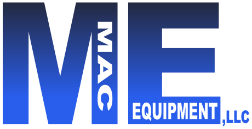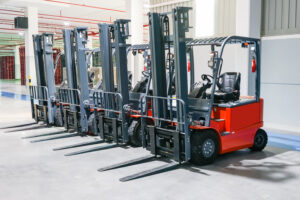Do you need a new forklift for your company warehouse? If your business is experiencing steady growth, you may need equipment with more complex and varied operational capacities. You may acquire more versatile product inventories that require a wide range of lifting options.
Perhaps your current warehouse needs include lifting and moving many different weight loads. Whatever your preferences and needs may be for a new forklift, you want to ensure that you choose the best model for your business.
What to Consider When Renting a Warehouse Forklift
Before making your rental decision for a warehouse forklift, take time to consider the following aspects of different brands and models:
Power Sources
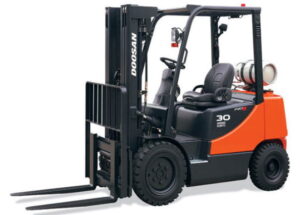
Powered forklifts require energy inputs from varied sources. They can be operated by a seated driver or a walking controller. Across the U.S., the usage of powered lifts is under the regulation of the Occupational Safety and Health Administration (OSHA).
All forklift operators are required to be no less than 18 years of age. Each operator must successfully complete training certification every three years. All forklift designs that lift and transport heavy loads must have a power source.
Approved sources of power for these heavy-duty forklifts include the following:
Liquid Propane
Liquid propane gas (LPG) is commonly used as fuel for forklifts. It is widely available, low-cost, and clean-burning. The majority of lifts use 33 cylinders of this propane fuel. Lifts that are powered by LPG can be operated indoors due to their quiet motors and safe, low emissions rates. Usually mounted on the lift truck back, the LPG tanks can be easily and efficiently removed and replaced as needed.
Diesel
Diesel forklifts have greater power output and lifting support than LPG lifts offer. They are a better choice for outdoor use than indoor work. This is because diesel emissions need good and continuous ventilation when in operation. Diesel engines also produce greater noise levels.
Electric
Electric forklifts operate quietly, creating no hazardous emissions. They are ideal for indoor lifting jobs. Battery designs include lead-acid batteries that are similar to batteries used in automobiles and lithium-ion batteries. To meet safety regulations, industries like healthcare and food processing facilities use only electric-powered forklifts.
Tires
Solid rubber (cushion) tires and pneumatic tires (air-inflated) are typically used for forklifts. Solid rubber tires are the ideal choice for operating on flat, well-supported surfaces. They do not rupture from exposure to sharp objects since they are made of sturdy rubber. For large loads, pneumatic tires are more efficient. They also run more evenly on rough surfaces.
Forklifts for Moving Different Product Types
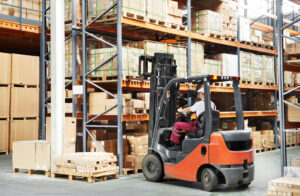 Although they are typically less expensive than pneumatic tires, cushion-tire forklifts run close to the ground. For this reason, they are not recommended for use on rough or uneven outdoor areas where large rocks and debris can interfere with their operation. For these more rugged, outdoor product lifting and moving projects, rough terrain lifts are needed. Cushion-tire forklifts are good for indoor warehouse lifting.
Although they are typically less expensive than pneumatic tires, cushion-tire forklifts run close to the ground. For this reason, they are not recommended for use on rough or uneven outdoor areas where large rocks and debris can interfere with their operation. For these more rugged, outdoor product lifting and moving projects, rough terrain lifts are needed. Cushion-tire forklifts are good for indoor warehouse lifting.
Their tires are usually significantly larger with greater gripping traction than cushion tires offer. These larger, rough-terrain tires resemble heavy-duty construction tires and tires designed for use on farm equipment. Some rough-terrain forklift models are equipped with stabilizers to ensure greater support. These sturdy models are ideal for loading and unloading heavy products from transport trucks and loading docks.
Forklift Classes: What Lifts are Ideal for Warehouse Use?
There are seven basic classifications for forklifts, and some classes are ideal selections for warehouse use.
Class I
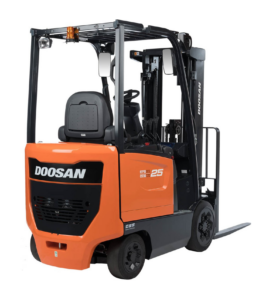 Electric Motor Ride Truck: This forklift class has an electric-powered engine. It is ideal for use for lifting and moving products in warehouse interiors for smooth, quiet operation. These electric lifts also promote quality air control.
Electric Motor Ride Truck: This forklift class has an electric-powered engine. It is ideal for use for lifting and moving products in warehouse interiors for smooth, quiet operation. These electric lifts also promote quality air control.
Class II
Electric Motor Narrow Aisle Truck: This lift design is battery-run. It is an excellent choice for lifting and relocating inventories within narrow, tight, or difficult-to-access areas inside warehouses.
Class III
Electric Motor Hand Truck: With the use of this type of battery-powered hand lift, you can load and unload truck deliveries to your warehouse storage spaces close by.
Class IV
Internal Combustion Engine With Cushion Tires: These forklifts are fueled with gas or diesel. They are recommended for use in low-clearance situations in warehouse settings due to their compact, efficient designs.
Class V
Internal Combustion Engine Trucks With Pneumatic Tires: Operating on gas or diesel fuel, this tye of forklift is equally equipped for good use on rough surface areas, both indoors and outdoors.
Class VI
Electric and Internal Combustion Engine Tractors: These sturdy forklift designs are well-suited for towing or hauling loads of varied sizes and weights. They operate on gas, diesel, or batteClass VII – Rough Terrain Forklift Truck.
Class VII
Rough Terrain Forklift Truck: This forklift design runs on gas or diesel fuel. It is recommended for use on uneven ground at construction sites and for lifting loads to and from significant heights for storage or use.
Types of Forklifts
There are varied designs of forklifts on the market today for use in and around warehouses, such as the following:
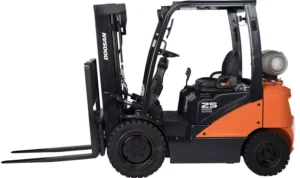
Warehouse Forklift
These forklifts are designed to perform various typical warehouse activities like lifting employees and equipment, moving and stacking materials and inventories, and stocking product orders. Warehouse lifts typically lift as much as 5,000 lbs., and some models can move up to 20,000 lbs. If needed.
Pallet Jack
These lifts, also called pallet trucks, pumps, scooters, dogs, or jiggers, are designed for repositioning pallets to different heights. Their simple designs include two forks that are usually 20-¼ inches to 27 inches in width. They are used for indoor warehouse lifting.
Structured with one or two bogie wheels, these lifts generally have frontal steering wheels. They lift loads using a hydraulic pump and can lift from 5,000 to 8,000 lbs.
The three commonly used types of pallet jacks are manual, powered, and rough terrain pallet jacks. Manual pallet jacks are hand-operated and very cost-efficient. Retail stores and warehouses often use these lifts. Powered models have engines for lifting heavier or stacked pallets and may have stand-on platforms for their operators. Rough-terrain models have reinforced frames and pneumatic tires, enabling them to operate well on rough, uneven surfaces.
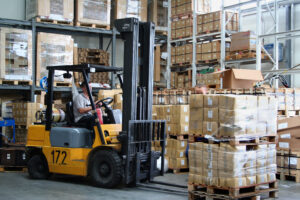
Order Picker
This type of forklift can lift one or two units with an operator. The operator stands on a platform that can be raised or lowered to different heights of racks or shelving. Inventory items can be quickly and efficiently removed or returned to and from storage as needed. Good for use in narrow spaces, these lifts can lift from 300 to 3,000 lbs. to heights of 32 feet.
Reach For Truck
These models can reach into racks in warehouses. They have outrigger legs and forks that reach forward and can lift as high as 30 feet. These lifts are ideal for the accurate placement of pallets on racks in warehouses. They can carry from 2,000 to 5,000 lbs.
Rough Terrain Forklift.
These forklifts are designed to supply excellent mobility and stable activity on rocky, sandy, slippery, or uneven surfaces. They are often used in forestry, construction, and farm work. They have large, sturdy tires and large engines, plus a strong cage cab for operators.
Industrial Forklift
This type of lift is a large-capacity model that can lift more than 30,000 pounds.
Counterbalance Forklift.
These lifts offer a large-size counterweight in the back of the truck for raising and lowering heavier loads. These lifts are good for use both indoors and outdoors on smooth, flat surfaces. Their turning radius is large, making them best for use in wide-open areas. They are sold in a three or four-wheel style.
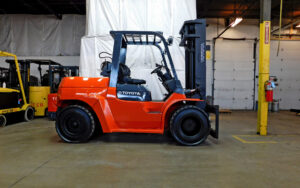
MAC Equipment’s Forklifts
The latest models in all types and designs of forklifts are available as rentals from MAC Equipment LLC. You can review all of their wide range of models by visiting the company website or calling the MAC Equipment experts today for consultation and advice.
Conclusion
There is a design and model of forklift currently available to meet all of your warehouse needs. Regardless of your type of business, you can obtain a forklift rental to handle all your outdoor and indoor warehouse activities. With the ideal lift model or models, you and your staff can load and unload inventory items, pallet loads, and more. You can position all loads and products on storage racks, shelving, or other designated storage areas.
